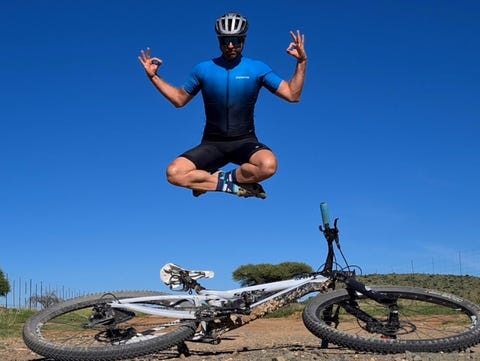How Setting Mini Goals Helps This Cyclist Stay Motivated and Healthy
Age: 33
Occupation: Civil Engineer
Hometown: Cape Town, South Africa
Start Weight: 125 kg (276 pounds)
End Weight: 83 kg (183 pounds)
Time Cycling: 3.5 years
Reason for Cycling: I can take my mountain bike up into the mountains on trails with views that 99 percent of the world never gets to experience. And the second reason is to keep healthy.
I started riding at 6 years old with my dad, and I did my first 20K “fun ride” on a BMX bike around that age. But I was inconsistent, never riding for more than two or three months at a time, before stopping altogether in high school.
After studying at university, I took a job on the road. It was difficult to establish a routine in my life, and I was living from gas station foods and fast foods almost daily. After four years in that job, I realized I was killing myself. I had to go for a check up for my life insurance policy, and they came back and told me I’d to pay more because of all the risk factors for that came along with poor health and obesity (such as heart disease and type 2 diabetes).
Soon, I saw the scale tip 125.1 kilograms (276 pounds), and as my life insurance policy began to penalize me for being obese, it hit me that I would have to start turning this ship around. The only real exercise that I could remember enjoying from my younger days was cycling. So, I bought a hardtail mountain bike and started riding again—but this time, with more determination. I set a clear goal of getting healthier and losing weight instead of just cycling for fun. (It’s still enjoyable though, I just do it with more purpose.)
On my first ride up the mountain,I had only ridden two kilometers before my heart rate shot through the roof and I started to get tunnel vision. I turned around in disbelief, realizing what horrible fitness condition I was in. Our local mountain route is 20K with just under 400 meters of elevation. Two days later, I told myself “I WILL finish this loop, no matter what, no matter how many times I have to stop and rest or push.” It took me two and a half hours to complete the loop that day, but that started my cycling journey.
As the cycling obsession took hold, focusing on nutrition and diet came with it. Instead of eating for pleasure, I started looking at food as a fuel source. I became a pro at counting calories and knowing what nutrition I needed for each type of ride and race. I actually have my wife to thank for this, since she taught me everything I know about nutrition.
Before, I’d eat pies, burgers, chips, and soda because it was easy to grab. Now, I focus on the calories I take in per day, but my diet mainly consists of veggies, fruit, chicken, red meat (in moderation), and eggs and dairy products (also in moderation). I also have found that intermittent fasting works for me, so I fast from 7 p.m. until 1:00 p.m. daily. I also try to cut out sugar. On Sundays I’ll have a cheat meal.
Now, over three years after my first attempt at that loop, I can complete it in 45 minutes. And, I just completed The Double Century 200K Team Time Trial Road Race. Our team finished top 10 in our category.

Currently, I’m training for longer mountain bike endurance events (such as a 230K ride with 3000 meters of elevation gain, and later this year the 36One race, where you ride 361K in 361 hours and the course takes you in a 361-degree loop). So I aim for around eight to 10 hours on the bike per week. Usually, I ride shorter sessions during the week, which includes of interval work, and then longer rides in heart rate zone 2 and 3 on the weekends.
I set big goals for myself every year. In 2020, I aimed for 7,000 kilometers of riding and 120,000 meters of elevation gain (I reached 9,300K and 119,200 m). For 2021, my goal is 8,000 kilometers of riding and 140,000 meters of elevation gain, adding gym sessions to my routine, and to get to 75kg. Apart from the big goals, I set myself mini-targets throughout the year that I try to hit.
I find myself more motivated when a mini-target is just a month away, instead of looking at a big goal 12 months away. I easily fall in the trap of thinking I still have plenty of time to get to work on it, so these help keep me going. I even use races as mini-targets. Pre-Covid, when events were still taking place, I tried to do a race at least once every two months. Eventually, I hope to become competitive in Cat A racing.
Source: Read Full Article



